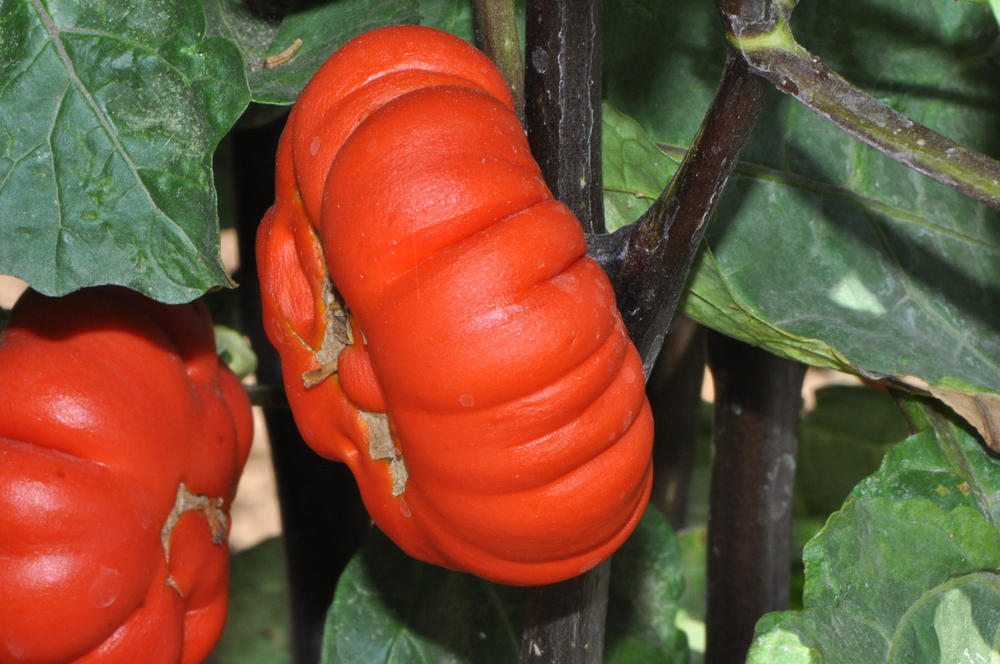Solanum aethiopicum

|
|
Solanum aethiopicum Common Names: African eggplant, scarlet eggplant,
bitter tomato, cleome Scientific
Classification Kingdom: Plantae Clade: Tracheophytes Clade: Angiosperms Order: Solanales Family: Solanaceae Genus: Solanum Species: S. aethiopicum Binomial Name: Solanum aethiopicum L. Synonyms: Solanum integrifolium Poir., Solanum gilo Raddi, Solanum ovigerum Dunal Morphological Description Solanum aethiopicum, widely known as the African eggplant or scarlet eggplant, is a
highly variable species that can grow as an annual or perennial subshrub,
reaching heights of up to 2.5 meters (Han, 2021). The plant is characterized by
its erect or sprawling stems, which are often covered with fine, stellate hairs
and occasional prickles, particularly on younger growth (Useful Tropical
Plants, n.d.). Its leaves are broad, ovate to oblong-ovate, measuring 10–30 cm
long and 8–20 cm wide, with entire or slightly lobed margins and a velvety
texture due to dense pubescence. The flowers are small, star-shaped, and borne
in clusters, with white to pale purple corollas approximately 1–2 cm in
diameter (Useful Tropical Plants, n.d.). The fruits are remarkably diverse,
ranging from spherical to elliptic or flattened shapes, with diameters of 2–10
cm (Han, 2021). Immature fruits are typically green, maturing to vibrant shades
of orange, red, or occasionally yellow, with a smooth, glossy surface. Both the
fruit and leaves are edible, with the pulp offering a bitter to mildly sweet
flavor depending on the cultivar and preparation method. Distribution and Habitat Native to tropical
Africa, Solanum aethiopicum is extensively cultivated across West Africa, including
countries like Nigeria, Ghana, and Senegal, as well as in Brazil, parts of Asia
(e.g., India and China), and southern Europe (Bissah & Su, 2021). It adapts
to a wide range of habitats, from humid lowland forests to dry rocky outcrops,
grasslands, and disturbed areas near human settlements (Useful Tropical Plants,
n.d.). The plant thrives in warm climates with temperatures between 20–35°C and
prefers well-drained soils with a pH of 5.5–7.0, though it can tolerate
extremes from 4.3 to 8.5 (Osei et al., 2018). It is often found at altitudes up
to 1,500 meters and requires annual rainfall of 600–1,500 mm for optimal growth
(Han, 2021). Ethnopharmacology Solanum aethiopicum holds a prominent place in traditional medicine across its
native and cultivated regions, valued for its anti-inflammatory,
immunosuppressive, and nutrient-rich properties. Below are key
ethnopharmacological uses supported by available research: · Anti-inflammatory Effects: In West Africa, leaf extracts are applied
topically or consumed as infusions to reduce inflammation associated with
arthritis and swellings. · Management of Hypertension and Diabetes: Fruits and leaves are used in Nigeria and
Ghana to manage high blood pressure and diabetes. Research indicates that the
plant’s phenolic compounds and antioxidants contribute to reducing blood
glucose levels by 20–30% in diabetic rats, supporting its traditional use
(Chinedu et al., 2017). · Skin Infections: Leaf poultices are employed to treat skin
conditions like abscesses and fungal infections in Uganda. The antimicrobial
properties of the plant, linked to saponins and steroidal glycosides, show
efficacy against pathogens such as Staphylococcus aureus and Candida albicans with a minimum inhibitory concentration
(MIC) of 250 μg/mL (Eze & Osuala, 2016). · Nutritional Therapy: The plant’s high content of vitamins
(e.g., vitamin C, 15–25 mg/100g) and minerals (e.g., potassium, 200–300
mg/100g) makes it a traditional remedy for malnutrition and anemia,
particularly in rural communities (Han, 2021). ⚠ Toxicity Profile: While Solanum aethiopicum is generally safe for consumption when
cooked or consumed in moderation, it contains saponins and glycoalkaloids
(e.g., solasodine), which contribute to its bitter taste (Chinedu et al.,
2017). Excessive intake of raw fruits or leaves may lead to mild
gastrointestinal distress, such as nausea or diarrhea (Useful Tropical Plants,
n.d.). Cooking reduces these compounds’ concentration, mitigating potential
adverse effects. Individuals with sensitivities to Solanaceae species (e.g.,
tomatoes, potatoes) should exercise caution. Additional Uses · Cultivar Diversity: The plant is divided into four cultivar
groups—Gilo (edible fruits of various shapes), Shum (leafy greens), Kumba
(large, flattened fruits), and Aculeatum (ornamental with prickly stems)—each
tailored to specific culinary or aesthetic purposes. · Ornamental Use: In Asia and Europe, the Aculeatum group is
grown for its striking red fruits and prickly foliage, enhancing garden
landscapes (Useful Tropical Plants, n.d.). · Agricultural Value: Its fast growth and adaptability make it a
key crop for food security in subsistence farming systems, with fruits yielding
up to 10 tons per hectare under optimal conditions. References
External Links More Pictures |
|
| Compounds of Solanum aethiopicum | |
| References |